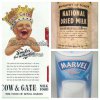Another interesting subject. Our milkman after the war ran a small ford 8 van, cream with green lining. He doled the milk out of churns with ladles and I remember, you left the jug/s on the front step and he ladled out your requirements. If the family were out all day, you had to make sure that milk was left in the coolest place possible, (the meter box or coal house with a cover on). He sold nothing but ordinary milk, I cannot remember his name, he always wore a white coat, brown gaiters and a cloth cap. He sold out to Handsworth Dairies and then we had their fine well maintained smaller floats visiting us (horse drawn) as opposed to the big floats that the Co-Op used. Theirs was a covered float drawn by a larger horse (small shire type, similar to their coal carts or the horse drawn railway parcels carts). Lady P will remember the top end of Court Lane by Oscott College had a wide grass strip in front of the last dozen or so houses before you got to the cemetery and college gates and regularly the horse drawn vehicles would be up on this as the animals chose something different in their diet. The interesting thing is that in the late 1940s, not only did the milk, coal, railway, bread (remember Scribbans bread wagons) companies use horse and carts, but every morning a Sentinel steam lorry would come down Court Lane. Who it belonged to or where it went I have no idea, but it was a regular hissing, chuffing visitor. That was only 70 odd years ago, it seems like yesterday sometimes. The two shops at the top end of Court Lane, both sold milk, but only Maddox the one next to the Greyhound sold 'sterra', which was always sneered at by my mother, but loved by my sister and I as well as my grandmother in Harborne who used nothing but, 'BECAUSE IT KEPT LONGER AND VERY RARELY WENT OFF'. We had no fridges (at least the clerical class did not) and milk lived in the pantry/larder (dependent on your upbringing). We had a pantry, my off Slade Road Gran had a larder. The point of all this is to ask one question. Where did Handsworth Dairies, Midland Counties Dairies, the Co=Op et al get their milk from and how was it delivered to them. I know when I moved to the West Country most railway towns had an Express Dairies/Cow and Gate dairy/creamery alongside the railway line and they regularly sent off refrigerated tankers to London,
Bob Davis












